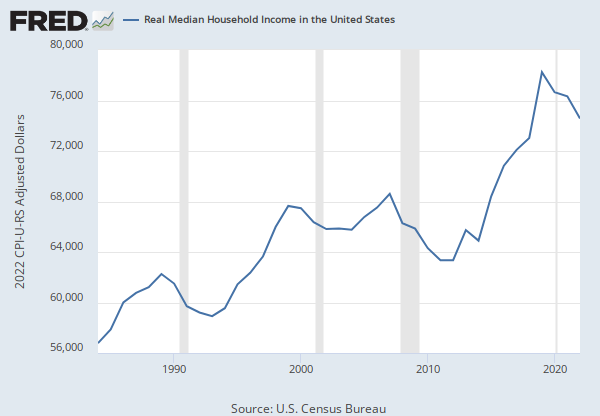Federal Reserve Economic Data: Your trusted data source since 1991
Data in this graph are copyrighted. Please review the copyright information in the series notes before sharing.
NOTES
Source: Board of Governors of the Federal Reserve System (US)
Release: Z.1 Financial Accounts of the United States
Units: Billions of Dollars, Seasonally Adjusted
Frequency: Quarterly, End of Period
Notes:
Source ID: LA154104005.Q
For more information about the Flow of Funds tables, see the Financial Accounts Guide.
With each quarterly release, the source may make major data and structural revisions to the series and tables. These changes are available in the Release Highlights.
In the Financial Accounts, the source identifies each series by a string of patterned letters and numbers. For a detailed description, including how this series is constructed, see the series analyzer provided by the source.
Suggested Citation:
Board of Governors of the Federal Reserve System (US), Households and Nonprofit Organizations; Debt Securities and Loans; Liability, Level [CMDEBT], retrieved from FRED, Federal Reserve Bank of St. Louis; https://fred.stlouisfed.org/series/CMDEBT, April 19, 2024.
Source: U.S. Bureau of Economic Analysis
Release: Gross Domestic Product
Units: Billions of Dollars, Seasonally Adjusted Annual Rate
Frequency: Quarterly
Notes:
BEA Account Code: A034RC
A Guide to the National Income and Product Accounts of the United States (NIPA) - (http://www.bea.gov/national/pdf/nipaguid.pdf)
Suggested Citation:
U.S. Bureau of Economic Analysis, Compensation of Employees: Wages and Salary Accruals [WASCUR], retrieved from FRED, Federal Reserve Bank of St. Louis; https://fred.stlouisfed.org/series/WASCUR, April 19, 2024.
Source: U.S. Bureau of Labor Statistics
Release: Employment Situation
Units: Thousands of Persons, Not Seasonally Adjusted
Frequency: Monthly
Notes:
Civilian noninstitutional population is defined as persons 16 years of age and older residing in the 50 states and the District of Columbia, who are not inmates of institutions (e.g., penal and mental facilities, homes for the aged), and who are not on active duty in the Armed Forces.
The series comes from the 'Current Population Survey (Household Survey)'
The source code is: LNU00000000
Suggested Citation:
U.S. Bureau of Labor Statistics, Population Level [CNP16OV], retrieved from FRED, Federal Reserve Bank of St. Louis; https://fred.stlouisfed.org/series/CNP16OV, April 19, 2024.
Source: U.S. Bureau of Economic Analysis
Release: Gross Domestic Product
Units: Index 2017=100, Seasonally Adjusted
Frequency: Quarterly
Notes:
BEA Account Code: A191RD
The number of decimal places reported varies over time. A Guide to the National Income and Product Accounts of the United States (NIPA).
Suggested Citation:
U.S. Bureau of Economic Analysis, Gross Domestic Product: Implicit Price Deflator [GDPDEF], retrieved from FRED, Federal Reserve Bank of St. Louis; https://fred.stlouisfed.org/series/GDPDEF, April 19, 2024.
Source: U.S. Census Bureau
Release: Income and Poverty in the United States
Units: Ratio, Not Seasonally Adjusted
Frequency: Annual
Notes:
Beginning with the 2003 Current Population Survey, there are revisions to the available race categories. Respondents are allowed to report more than one race, making selections from a "flash-card" listing. These six race categories are: White, Black or African American, American Indian or Alaskan Native, Asian, Native Hawaiian or Other Pacific Islander, and Other race. The last category includes any other race except the five mentioned. Because of these changes, data on race are not directly comparable to previous series. White Alone, Black Alone, and Asian Alone refer to people who reported White, Black, or Asian and did not report any other race category. Hispanic Origin refers to persons answering the question asking if the person is Spanish, Hispanic, or Latino. If their response is "yes", a follow-up question determines a specific ethnic origin, asking the person to select from a flash-card listing. These selections are Mexican, Mexican-American, Chicano, Puerto Rican, Cuban, Cuban American, or some other Spanish, Hispanic, or Latino group. Use caution when interpreting changes in the racial composition of the U.S. over time.
Suggested Citation:
U.S. Census Bureau, Income Gini Ratio for Households by Race of Householder, All Races [GINIALLRH], retrieved from FRED, Federal Reserve Bank of St. Louis; https://fred.stlouisfed.org/series/GINIALLRH, April 19, 2024.
RELEASE TABLES
- Table A-1. Employment status of the civilian population by sex and age: Monthly, Not Seasonally Adjusted
- Monthly, Seasonally Adjusted (population data is not adjusted for seasonal variation; not seasonally adjusted version used)
- Table 1.1.9. Implicit Price Deflators for Gross Domestic Product: Quarterly
- Table 1.12. National Income by Type of Income: Quarterly
- Table 2.1. Personal Income and Its Disposition: Quarterly
- Table 2.2B. Wages and Salaries by Industry: Quarterly
RELATED DATA AND CONTENT
Data Suggestions Based On Your Search
Content Suggestions
Other Formats
Households and Nonprofit Organizations; Debt Securities and Loans; Liability, Level
Quarterly, Not Seasonally Adjusted Millions of Dollars, Annual, Not Seasonally Adjusted Millions of Dollars, Annual, Seasonally AdjustedGross Domestic Product: Implicit Price Deflator
Percent Change from Preceding Period, Annual, Not Seasonally Adjusted Percent Change from Preceding Period, Quarterly, Seasonally Adjusted Annual Rate























































